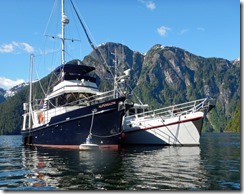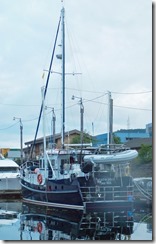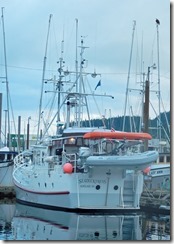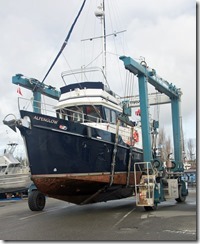The IVF dock in downtown Juneau is about 12 miles by car from the docks where we normally stay at in Auke Bay. By water, it is about 20 miles virtually circumnavigating Douglas Island, as the direct route via the Mendenhall Bar (no it is not a tavern, but the outflow from the Mendenhall Glacier), is only negoiable at high tide by shallow draft boats with local knowledge of the shifting channel. We weren’t actually going to Auke Bay but we traveled pretty close to there as we headed to Swanson Harbor where we intended to tie up to the public dock.
The water was dead calm as we made good time up Stephens Passage toward the junction with Lynn Canal at the north end of Admiralty Island. Many of the whale watching  boats loaded with cruise ship passengers leave from Auke Bay and we are regularly passed by them as they darted about looking for humpback or orca whales. In our case, we had an orca whale pass close by on a course up channel.
boats loaded with cruise ship passengers leave from Auke Bay and we are regularly passed by them as they darted about looking for humpback or orca whales. In our case, we had an orca whale pass close by on a course up channel.
Winds out of the north picked up as we approached Swanson and were blowing a steady 15 knots as we made our attempt to dock. Nobody was on the dock and with the wind blowing us off the dock, we weren’t able to get in and stay on the dock long enough to tie up. Since the anchoring grounds in Swanson were also exposed, we headed to Funter Bay where we found much calming conditions and had a pleasant night at anchor.
We had a short day to our next anchorage in Flynn Cove, so we waited until the wind laid down and the tide switched in our favor. Vessel entry into Glacier Bay National Park is limited and the NPS looks dimly on people coming before their permit starts. Flynn Cove is one of the closer anchorages to the park and we use it most years before we enter.
After we entered the park, we headed towards Bartlett Cove where the visitor center and lodge are located. We needed to complete an annual boater’s orientation before proceeding up the bay further. At the dock where we tied up, another boater strongly recommended an anchorage very close to the glaciers at the northern end of the park. It is not very sheltered but in calm conditions, which were forecast, it is safe.
 After the orientation, we headed to Shag Cove in Geike Inlet. It is a deep anchorage and only accommodates one or two vessels but is lovely. The weather was generally calm but low marine air greeted us the next morning. It reminded me a bit of Misty Fjords National Monument near Ketchikan.
After the orientation, we headed to Shag Cove in Geike Inlet. It is a deep anchorage and only accommodates one or two vessels but is lovely. The weather was generally calm but low marine air greeted us the next morning. It reminded me a bit of Misty Fjords National Monument near Ketchikan.
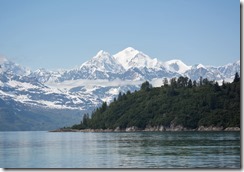 Despite the early morning clouds the sun came out and we headed up Tarr Inlet near the north end of Glacier Bay where the Margerie and Grand Pacific glaciers are. Mount Fairweather stood out prominently as cruised along. We timed our arrival towards the end of the day after the cruise ships and tour boat had left. The ice debris in the water was lighter than we had seen in our previous 5 trips so we had no problem making our way to the glacier face and then to our anchorage less than 2 miles away.
Despite the early morning clouds the sun came out and we headed up Tarr Inlet near the north end of Glacier Bay where the Margerie and Grand Pacific glaciers are. Mount Fairweather stood out prominently as cruised along. We timed our arrival towards the end of the day after the cruise ships and tour boat had left. The ice debris in the water was lighter than we had seen in our previous 5 trips so we had no problem making our way to the glacier face and then to our anchorage less than 2 miles away.
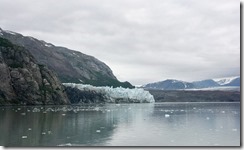 The anchorage was simply stunning and we enjoyed the evening on our fly bridge listening to the black-legged kittiwakes flying above us and the rumbles of the glaciers in the distance. We watched the ebb and flow of ice chunks past our boat. The next morning was calm but the clouds had thickened overnight.
The anchorage was simply stunning and we enjoyed the evening on our fly bridge listening to the black-legged kittiwakes flying above us and the rumbles of the glaciers in the distance. We watched the ebb and flow of ice chunks past our boat. The next morning was calm but the clouds had thickened overnight.
It was on to another old standby, North Sandy Cove. Some whales were feeding near the entrance but not so close that we couldn’t get by them without disturbing them. Surprisingly, we were the only boat in the inner cove that night.
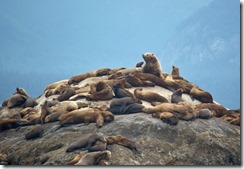 The next day we did the slow cruise by South Marble Island to see, hear and smell the Stellar Sea Lion colony on the rocks. Of course, there were ample numbers of Tufted Puffins feeding in the waters.
The next day we did the slow cruise by South Marble Island to see, hear and smell the Stellar Sea Lion colony on the rocks. Of course, there were ample numbers of Tufted Puffins feeding in the waters. Lastly, we had a brilliant display of acrobatics by one humpback whale which would leap from the water three times in quick (for a whale anyway) succession, rest for a few
Lastly, we had a brilliant display of acrobatics by one humpback whale which would leap from the water three times in quick (for a whale anyway) succession, rest for a few 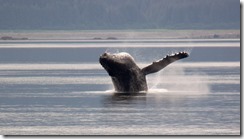 minutes and then repeat the performance. We watched it for more than 20 minutes before it resumed normal feeding and we moved on to our next anchorage in North Finger Bay.
minutes and then repeat the performance. We watched it for more than 20 minutes before it resumed normal feeding and we moved on to our next anchorage in North Finger Bay.
The last two nights in Glacier Bay were spent in Bartlett Cove. The afternoon of our arrival, we paddled our kayaks up the Beardslee Cutoff a short distance. That route is the protected channel by which kayakers are able to move up bay. The next day we did the Bartlett River hike followed by lunch and a quick load of laundry at the lodge.
 The last anchorage before Hoonah was back in Flynn Cove. We tried some halibut fishing before going in but only a couple of small bottom fish nibbled. After we dropped the anchor, Marcia set a “meat hook” down (i.e., a baited hook on a pole that you leave unattended, other than adjusting for tidal changes periodically). As we were watching TV (15 minutes from the end of a Midsomer Murder), Marcia heard an odd noise, went out and investigated then reeled up a 36” halibut! She spent the hour before bedtime fileting it.
The last anchorage before Hoonah was back in Flynn Cove. We tried some halibut fishing before going in but only a couple of small bottom fish nibbled. After we dropped the anchor, Marcia set a “meat hook” down (i.e., a baited hook on a pole that you leave unattended, other than adjusting for tidal changes periodically). As we were watching TV (15 minutes from the end of a Midsomer Murder), Marcia heard an odd noise, went out and investigated then reeled up a 36” halibut! She spent the hour before bedtime fileting it.
Its now on to Hoonah and from there a slow trip down to Craig on Prince of Wales Island.


